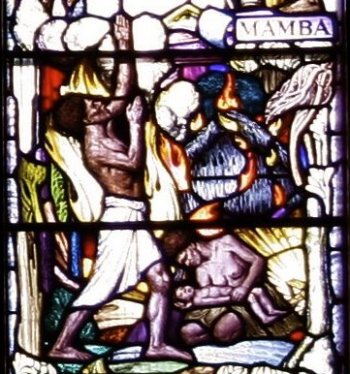
In the right light, the panel above the lowest is a graphic representation of the destruction by fire and bombs of the native villages. The hut in the background is in flames and, beneath this, a woman cradles a dead child on her lap. This image is surely to be contrasted with the similar woman and child in the idyllic scene of tranquil beauty in nature at the top of the left light of this window. Perhaps it is the hut seen in the background of that first image that is being destroyed here. The male figure in the foreground of this scene appears to be indicating the sky from which the destruction rains—in a gesture depicting both fear and defiance.
The caption to this scene is "Mamba". This was the area of a mission station somewhat to the west of those already mentioned, which were around Popondetta. The missionary at Mamba was Archdeacon Romney Gill, who also stayed in Papua during the Japanese occupation. He avoided capture by hiding out in the jungle, surviving with the assistance of the local people. This is an important reminder that not all of those who elected to stay with their people in the missions were killed: some, like Archdeacon Gill, avoided capture by hiding in the jungle; and some were captured, but survived the war in prison camps. This panel might, then, be understood as pointing to the fact that, while in some instances the missionaries were not killed, the invasion still brought death and destruction to the native people and their villages.
The horizontal theme of Truth can be seen to apply directly to this scene, albeit in a less positive way than in the adjacent panels. Death and destruction are a part of this world, and if the truth is to be told, these negative things must also be recognized.
Bishop Strong, on the other hand, suggests that the themes of Beauty, Truth and Goodness should follow the story upwards in this right-most light. Under that reading, he interprets this panel in the following words: "With the third from the top is depicted the destruction of native villages and the sufferings of the native people. It symbolizes beauty being destroyed by war and wickedness, as is still happening all over the world today in many spheres and ways; the attempts of the powers of evil to undermine and mar God's handiwork in the life of the Church and of the world."